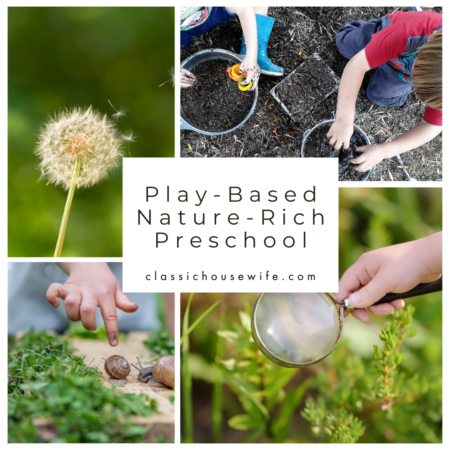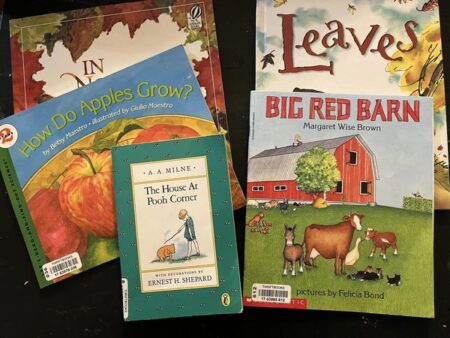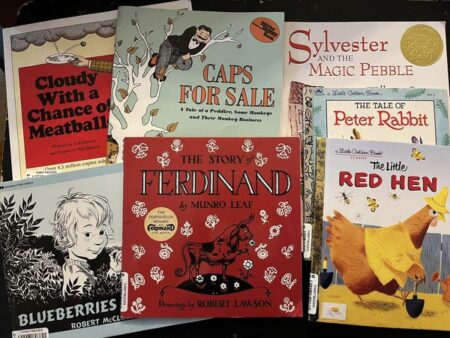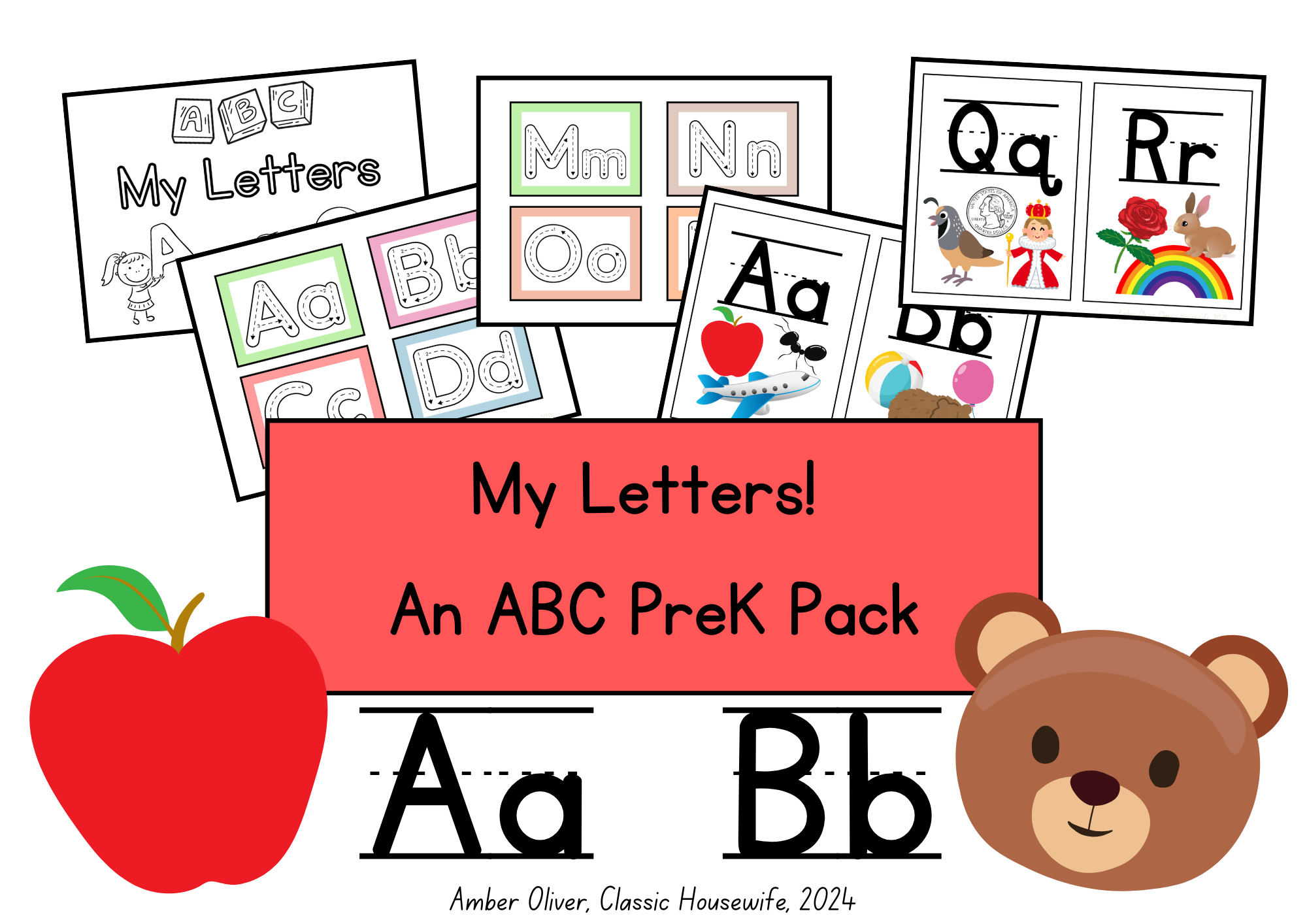After so many years of experience and several months of researching, I still don’t know what to call our preschool approach: “a little Montessori/Waldorf/Reggio with a lot of nature and play and reading?” That doesn’t exactly roll off the tongue. I’m going to have to settle (for now) with just “play-based nature-rich preschool.” I think that about does it.
Whatever it’s “called” doesn’t matter anyway, (and honestly it’s only very slightly different than what we have been doing for the past couple of years already.) =) I’ve been using seasonal and holiday themed sensory bins, invitations to play, and colorful books from season to season and holiday to holiday since our little Mouse was just a wee toddler. As I’ve said, in these first few years, kids are constantly learning and absorbing anyway – all you need to do is provide plenty of opportunities!
That said, I do want to introduce a little more structure in our environment for our first real preschool year, to guide us in a flow through the year. And to that end, I’ve compiled a set of unit-study-like themes for each month of the school year, around which to create our sensory bins, invitations to play, read-alouds, and field trips, Meanwhile I want to provide plenty of play, exploration, and time outside as allowable.

Play-Based Nature-Rich Preschool Themes for the Year:
- August: “Apples and Seeds” – studying fruit trees, apples specifically, life cycle of a seed, science, baking, canning, sprouting apple seeds, planting apple trees, apple themed crafts (Apples and Seeds Resource Unit.)
- September: “On the Farm” – studying farm animals, farm equipment, planting and harvesting seasons, where our food comes from, visiting large and small farms, shopping the farmers market, starting our fall garden, making cheese, making yogurt
- October: “Fall and Deciduous Trees” – studying common trees and leaves, acorns, tree rings, bark, why leaves change colors, weather changes, seasonal changes, making leaf prints, nature hikes, making homemade paper
- November: “Pumpkins and Gourds” – studying pumpkins and gourds, how they grow, harvesting a pumpkin, roasting seeds, making pumpkin puree, baking, make a gourd birdhouse, thanksgiving, visit pumpkin patch, animals that love to eat pumpkins and gourds
- December: “Evergreens and Conifers” – studying evergreens, looking for conifers, how conifers reproduce, sprouting a pinecone, making pinecone crafts, making homemade wreaths, Christmas, visiting a tree farm, make an evergreen potpourri, making cut out cookies from scratch
- January: “Winter and the Types of Weather” – studying the winter season, weather types, cloud types, water cycle, rain and snow, animals that hibernate during the winter, snowflakes, snowflake crafts, baking bread from scratch, winter nature walks, making fake snow (playing in real snow if we get any)
- February: “Healthy Habits” – studying body and health, vitamins, protein, other essential nutrients, food groups, healthy activity, brushing teeth and hair, good sleep habits, tidying, manners, planning our spring garden, cooking skills, chopping skills, planning a balanced meal or snack, Valentine’s Day
- March: ” Spring and Animal Habitats” – studying the spring, different types of animal habitats, animal babies, put out new hummingbird feeders late march, make a frog hotel for the garden, wildflower nature walk, pick wildflowers, make pressed flowers, dry flowers, study the bluebonnet, visit the garden center to buy two fruit trees to plant, starting seeds indoors
- April: “Birds and Bugs” – studying our backyard birds, eggs, life cycle of egg-laying animals and insects, building birdhouses, making bird seed treats, caterpillars and butterflies, moths, ladybugs, pill bugs, starting outdoor planting, protecting garden from birds and bugs naturally, feather crafts, different ways to cook eggs, naturally dying eggs for color study, studying Easter/Resurrection
- May: “Summer and the Sun” – studying the season of summer, the sun, measuring temperature, direct sowing summer crops, water and light for plants, photosynthesis, hydration, melting and evaporation, summer activities, sun-bleaching crafts, light and dark, shadows, refraction and rainbows, days/weeks/months/years
Mapping Out the Preschool Plan for Each Month
After brainstorming topics for each month, the next step was a simple “no brainer” for me. Using lists of time tested read aloud books, book lists from Five in a Row and lists of Caldecott award winners, I began compiling a monthly list of theme-related read aloud books as well as an additional read aloud goal list for the whole year.


Using my teacher discount at Thriftbooks.com and searching for deal items, I ordered a stack of books to get our school year started. We will have library days every Tuesday afternoon and try to find many of the books from our list that way. For everything else, there’s Amazon. 
In addition to reading lists, I plotted out a handful of weather appropriate and theme-related activities for the month. For example, we don’t live in an area with apple orchards (sadly–I looked!) But we found a friend with a pear tree and we picked some pears instead. We will be making pear butter with those pears today!
And lastly, I’ve been working on Pinterest boards with hands on activities, crafts, projects, sensory bins, games, and experiments. Lil Miss Mouse LOVES doing things with her hands. She literally asks to do crafts EVERY SINGLE DAY. Crafts and projects are fun, and learning should be fun, so learning includes crafts and projects. It’s “preschooler math.” 
The Three R’s?
What about the reading, writing, and arithmetic? She will definitely be learning to read, count, and write, but that will be scattered naturally throughout everything we do.
I do have some additional practice worksheets I’ve made for her that we will use to provide some focused attention on these skills, but most of the learning will happen more spontaneously as we do everything else. From previous experience, I know that she will learn to read when she’s ready and not until she’s ready, so my approach for preschool is to provide opportunities without demand. I don’t want her to become resistant to reading and writing.
Also, little hands are often still busy learning the skills necessary for writing, so a lot of the learning that does happen will be done verbally or with manipulatives with plenty of fun and games. There’s no rush!
Putting our Play-Based Preschool Into Action
It’s been a LONG time since I’ve had a preschooler, but I remember that our focused “preschool time” only took about 30 minutes a day. However, never before have I had an only child! There are no siblings to send her off to play with (and she wants to play all day long!) Just a little bit of structure and planning will help with both of those.
The structure and planning: daily read aloud and activity at 10am, library days and gymnastics on Tuesday afternoons, play dates and/or park days on Wednesday mornings, homeschool co-op on Thursdays, babysitter days every other week, and monthly field trips. Also: sensory bins, loose parts, and invitations to play rotated weekly.
She and I also started making handmade items from our garden and foraged things this past spring (such as rose petal sugar scrub, dandelion jelly, and wildflower seed bombs.) We have sunflower jelly, sunflower lemon sugar scrub, salted caramel pear butter, and handmade cards planned for this month so that will keep us busy a lot, too.
I’ll share our monthly unit-study-like plans in more detail later, as well as our handmade projects as we make them. Follow along and learn along with us, too.
**Take this homeschool style quiz to learn more about your own style. My top three were, not surprisingly, unschooler, unit study, and Charlotte Mason (but then Montessori and What is Waldorf Homeschooling? – Homeschool Plus and Reggio Emilia weren’t options.) 

